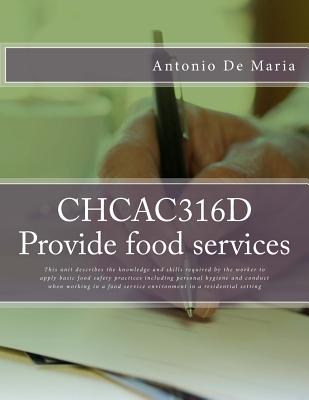You are here
Back to topCHCAC316D Provide food services: This unit describes the knowledge and skills required by the worker to apply basic food safety practices including pe (Paperback)
Email or call for price
Description
This unit describes the knowledge and skills required by the worker to apply basic food safety practices including personal hygiene and conduct when working in a food service environment in a residential setting. It contains Employability Skills This unit supports the implementation of national and state food safety legislation and regulations and is based on the national Food Safety Guideline Units of competency. Available on Amazon and Kindle. It will teach you to do the following; 1.1Carry out food handling according to the food safety program 1.2Identify and report processes or practices which are not consistent with the food safety program 1.3Take corrective action within the level of responsibility, according to the food safety program 1.4Maintain the workplace in a clean and tidy order to meet workplace standards 2.1Ensure personal hygiene meets the requirements of the food safety program 2.2Report health conditions and/or illness as required by the food safety program 2.3Wear clothing and footwear appropriate for food handling task and to meet requirements of the food safety program 2.4Ensure storage area is kept free from contaminants 3.1Receive and check food deliveries against organisation records 3.2Transport food safely and hygienically 3.3Ensure selected food storage environments are appropriate to specific food type 3.4Maintain appropriate environmental conditions for specific food types 3.5Prior to meal delivery, check each meal against appropriate documentation 3.6Reheat meals, if required, according to food regulations 3.7Complete meal tray assembly and check for accuracy according to established routines and procedures 3.8Prepare beverage utensils for use 3.9Deliver meals and/or beverages and leave in the appropriate place for client within the designated timeframe 3.10Replace missing or incorrect meals and/or beverages with appropriate meals and/or beverages 3.11Refill water jugs to address specific client requirements according to established policy and procedure 3.12Check room numbers, bed numbers and client name against appropriate documentation 3.13Assist client to sit up if required, in accordance with organisation policy and under the direction of an appropriate health professional 4.1Collect trays and all utensils after client has finished eating 4.2Check tray for foreign objects and stack safely on trolley 4.3Return dirty beverage utensils for cleaning 4.4Maintain stock of clean beverage utensils 4.5Collect empty water jugs 4.6Depending upon the scope of the work role, report insufficient food or fluid intake to the appropriate personnel according to enterprise procedures 4.7Seek client feedback on general acceptance/ satisfaction with meals and report to appropriate personnel according to enterprise procedures 5.1Identify a range of foods to meet the nutritional needs of the client groups 5.2Accurately follow standard recipes to ensure product consistency, nutritional integrity and to minimise wastage 5.3Prepare appropriate meals for specific client groups in an appetising and attractive manner 5.4Modify food texture to meet the needs of client groups and to meet enterprise standards 5.5Serve/plate meals appropriate to the setting, using appropriate portion control equipment as required 5.6Evaluate meals against organisation standards You will learn about; The food safety requirements and procedures related to own work. These depend on the nature of food handled and food handling responsibilities Possible consequences of not following these procedures Legal responsibilities relating to personal hygiene practices and the reporting of illness as required by the food safety program Including restrictions on; Clothing & footwear Personal clothing maintenance, laundering and storage Appropriate bandages and dressings Suitable standard for materials, equipment Responsibilities for maintaining a work area Use and store cleaning equipment Waste collection.
About the Author
The author and Chief Editor is Antonio De Maria, who has worked in this field for over 28 years. Tony is the founder, a past CEO and Director of the Enable Group, a Company providing Rehabilitation, Training and Recruitment, committed to promoting a skilled workforce. He has worked in the Community Services, Health and Disability Sectors since 1978, in a number of roles, including Educator, Case Manager, Training Officer, University Lecturer, Human Resource Manager, Registered Nurse, Therapist, and Advocate, for a variety of government and non government agencies. He has a Bachelor of Applied Science (Developmental Disability) and is a Nationally Accredited Vocational Trainer and Assessor. Tony has had a long-term commitment to Disability and Aged Care Sector reforms and Advocacy, and has committed Enable Learning Guides to continue this work. The proceeds of these resources contribute to continuing research and development in the industry. From the Author Antonio De Maria B App. Science (Disabilities) Cert 4 Workplace Training, Registered Nurse These books have been written with the worker, the client or person being supported, and the organisation in mind so that all stakeholders are served. This book is a compilation of over 28 years of work in which I personally have been involved. Thanks to my specialist colleagues and other team members who have provided me with information and advice, I am able to update these periodically. I have included many best practices in a professional yet straightforward way so the worker can use it as not only a learning reference but long after when they need to review a part of their job role. This book does not just contain theory; it's about a hands-on approach! You should use it as a tool for your learning, and in addition you should make sure you interact with the supervisors and mentors you have in a workplace. For VET practitioners; If it is being used in the VET sector, you should be mindful of all local legislation, and regulations, and take care that as an assessor you ensure you implement the critical and essential aspects of the assessment requirements. You may wish to moderate this, and vary the assessments, as you may find that in your situation you may not require all the assessments I have included, or may find you wish to add a supplementary assessment as well. These practices are based on best practices and adaptable internationally across many work or domestic environments

